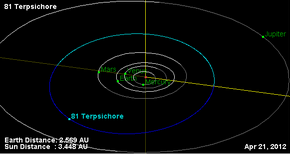 Orbital diagram | |
| Discovery | |
|---|---|
| Discovered by | Ernst Wilhelm Tempel |
| Discovery date | September 30, 1864 |
| Designations | |
| (81) Terpsichore | |
| Pronunciation | /tɜːrpˈsɪxərɛ/ [1] |
Named after | Terpsichore |
| Main belt | |
| Adjectives | Terpsichorean /tɜːrpsɪxəˈriːən/ [1] |
| Orbital characteristics | |
| Epoch December 31, 2006 (JD 2454100.5) | |
| Aphelion | 516.955 Gm (3.456 AU) |
| Perihelion | 337.132 Gm (2.254 AU) |
| 427.044 Gm (2.855 AU) | |
| Eccentricity | 0.211 |
| 1761.647 d (4.82 a) | |
Average orbital speed | 17.43 km/s |
| 149.581° | |
| Inclination | 7.809° |
| 1.497° | |
| 50.234° | |
| Physical characteristics | |
| Dimensions | 121.77 ± 2.34 km [2] |
| Mass | (6.19 ± 5.31) × 1018 kg [2] |
Mean density | 6.54 ± 5.62 g/cm3 [2] |
| 10.943 hr | |
| 0.051 [3] | |
| C | |
| 8.48 | |
81 Terpsichore is a large and very dark main-belt asteroid. It has most probably a very primitive carbonaceous composition. It was found by the prolific comet discoverer Ernst Tempel on September 30, 1864. [4] It is named after Terpsichore, the Muse of dance in Greek mythology.
Contents
Photometric observations of the minor planet in 2011 gave a rotation period of 10.945±0.001 h with an amplitude of 0.09±0.01 in magnitude. This result is consistent with previous determinations. [5] Two stellar occultation events involving this asteroid were observed from multiple sites in 2009. The resulting chords matched a smooth elliptical cross-section with dimensions of 134.0±4.0 km × 108.9±0.7 km. [6]